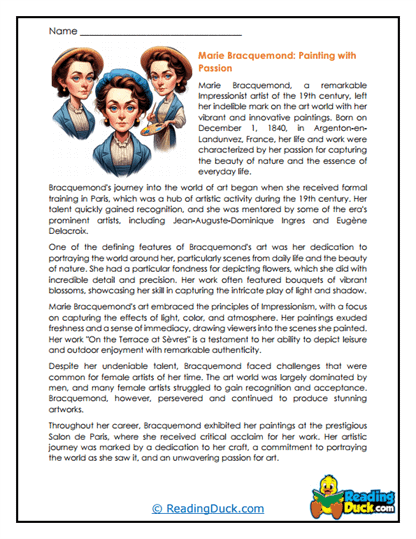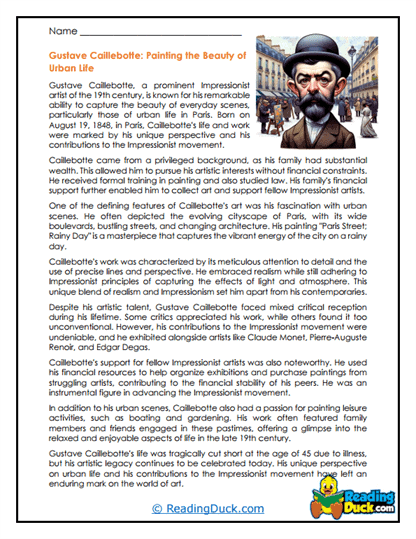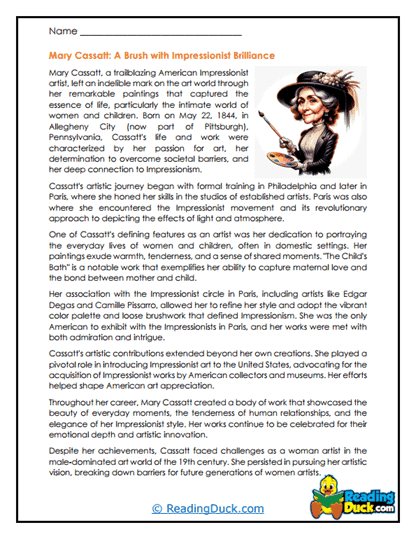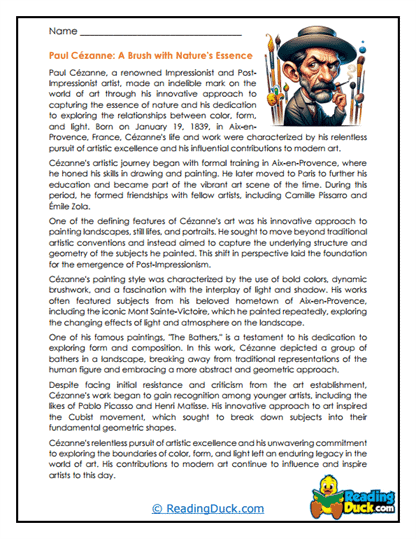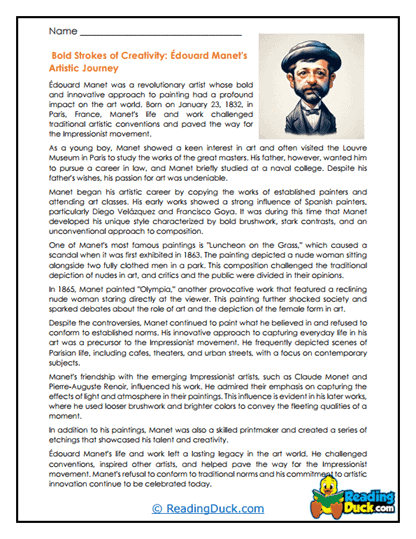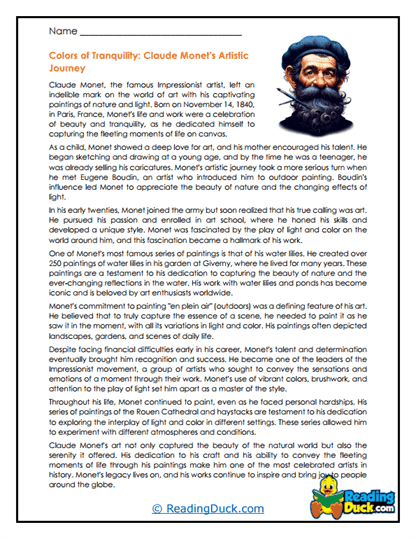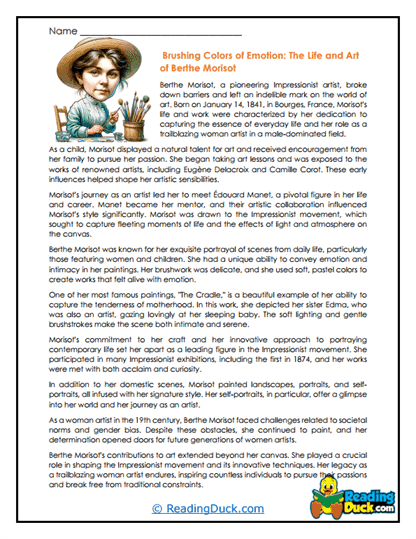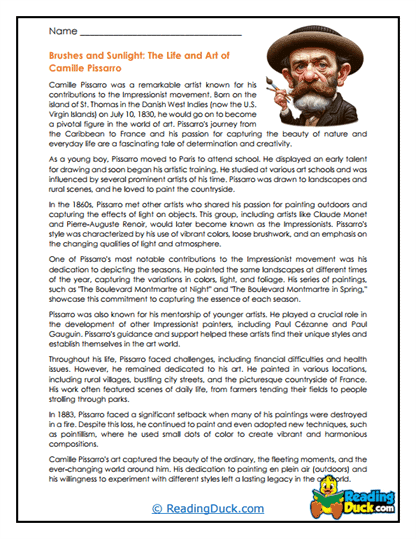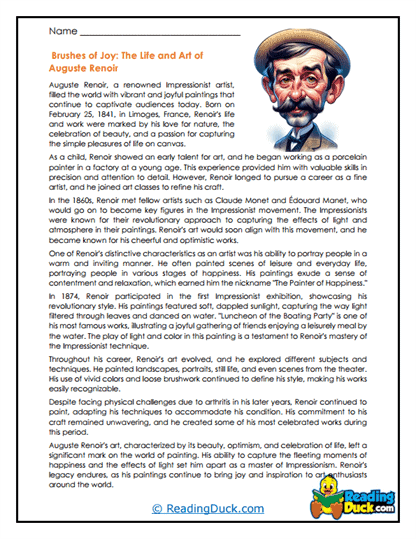Impressionism Artists Worksheets
About Our Impressionism Artists Worksheets
Our Impressionism Artists Worksheets offer a captivating exploration of one of the most influential art movements of the 19th century. These worksheets are designed to help students understand the key characteristics, techniques, and artists associated with Impressionism, fostering a deeper appreciation for this revolutionary style of painting.
Each worksheet set includes:
- Multiple Choice Questions: These questions assess students' comprehension of the reading passages, focusing on essential details about the artists, their techniques, and the significance of the Impressionist movement.
- Short Answer Questions: Students are prompted to provide concise responses, summarizing critical information, analyzing artistic methods, and reflecting on the impact of Impressionism on the art world.
- Open-Ended Questions: These questions encourage students to think critically and express their personal interpretations, opinions, and preferences regarding Impressionist art, allowing for a more personalized connection to the material.
These worksheets are designed to help students demonstrate their understanding of Impressionism and deepen their engagement with the subject. An answer key is provided for each question sheet, making it easy for teachers and parents to evaluate student progress. The worksheets are available in PDF format, ensuring they can be easily viewed electronically, downloaded, and printed.
The Light and Color of Impressionism: Exploring a Revolutionary Art Movement
Impressionism was a groundbreaking art movement that emerged in France during the late 19th century. It marked a dramatic departure from traditional artistic conventions, focusing instead on capturing the fleeting effects of light and color in everyday scenes. Impressionist artists sought to convey the atmosphere of a moment rather than meticulously detailed representations, resulting in a fresh, vibrant style that forever changed the course of art history.
Students exploring Impressionism will delve into several key aspects:
- Key Characteristics of Impressionism: Impressionism is known for its loose brushwork, emphasis on light and shadow, and vibrant use of color. Unlike the detailed, realistic depictions of earlier art forms, Impressionist works often appear more abstract, as artists aimed to capture the essence of a scene rather than its precise details. Students will explore how these techniques were used to convey movement, atmosphere, and the play of natural light.
- Influential Impressionist Artists: The Impressionist movement was led by a group of pioneering artists who broke away from the traditional art establishment. Students will study the works of key figures such as Claude Monet, whose paintings of water lilies and haystacks are iconic; Pierre-Auguste Renoir, known for his luminous portraits and scenes of social gatherings; and Edgar Degas, famous for his dynamic compositions of dancers and racehorses. Each of these artists brought a unique perspective to Impressionism, contributing to its diversity and richness.
- Techniques and Innovations: Impressionist artists experimented with a variety of techniques that set their work apart from previous styles. Students will learn about the use of short, broken brushstrokes that create a sense of movement and energy, as well as the technique of painting en plein air (outdoors), which allowed artists to capture natural light in real time. The exploration of color theory, including the use of complementary colors and optical mixing, will also be discussed.
- Cultural and Historical Context: The rise of Impressionism was influenced by the social and technological changes of the time, including the advent of photography, which challenged traditional notions of realism in art. Students will examine how the Industrial Revolution, urbanization, and changes in leisure activities shaped the subjects and themes of Impressionist paintings. Additionally, they will explore the initial rejection of Impressionism by the art establishment and its eventual acceptance as a legitimate and influential movement.
- Themes and Subjects: Impressionist artists often focused on everyday scenes, capturing the beauty of ordinary life. Students will explore the themes commonly found in Impressionist works, such as landscapes, cityscapes, leisure activities, and moments of modern life. The movement's emphasis on capturing the fleeting effects of light and atmosphere led to a focus on moments of transition—sunrise, sunset, and the changing seasons.
- The Legacy of Impressionism: Although initially controversial, Impressionism laid the groundwork for many subsequent art movements, including Post-Impressionism, Fauvism, and Abstract Expressionism. Students will explore how the innovations of the Impressionists influenced future generations of artists and continue to resonate in contemporary art. The global spread of Impressionism, particularly its impact on American and European artists in the late 19th and early 20th centuries, will also be discussed.
Through the study of Impressionism, students will gain a deeper understanding of how this movement challenged and expanded the boundaries of art, paving the way for modern and contemporary artistic expressions.
How Teachers and Parents Can Integrate These Worksheets in a Learning Curriculum
Integrating the study of Impressionism into a learning curriculum can provide students with valuable insights into art history, technique, and creative expression. Here are some practical ideas for using these worksheets in the classroom or at home:
- Create a Timeline of Impressionism: Use the worksheets to help students create a timeline that traces the development of Impressionism, highlighting key artists, works, and events. This activity can help students understand the chronological progression of the movement and its influence on later art styles.
- Connect Art with History and Culture: Integrate the study of Impressionism with lessons on 19th-century history and culture. Discuss how the social changes of the time, such as urbanization and the rise of the middle class, influenced the subjects and themes of Impressionist art. This cross-disciplinary approach can deepen students' understanding of both art and history.
- Group Projects and Presentations: Encourage students to work in groups to research a particular Impressionist artist or theme. They can present their findings to the class, enhancing their research, collaboration, and presentation skills. This activity can also include creating visual presentations that showcase the artists' work.
- Art Replication Exercises: After studying the techniques used by Impressionist artists, have students create their own artwork inspired by these methods. They can experiment with loose brushwork, outdoor painting, and the use of light and color to capture scenes from their everyday lives. This hands-on project allows students to connect theory with practice.
- Field Trips or Virtual Museum Tours: If possible, organize field trips to art museums or galleries that feature Impressionist works. Alternatively, use virtual tours to explore famous collections like those in the Musée d'Orsay in Paris. These experiences can make the art come alive and provide context to the material studied in the worksheets.
- Supplemental Homework Assignments: Use the worksheets as homework assignments to reinforce in-class learning. Students can complete the reading passages and questions at home, allowing for more in-depth exploration of Impressionism.
- Incorporate Multimedia Resources: Encourage students to explore Impressionism through various media, such as documentaries, online galleries, and art apps that allow them to interact with famous works. This multimedia approach can enhance their understanding and engagement with the movement.
- Tailor to Different Grade Levels: Adapt the complexity of the worksheets to suit different grade levels. Younger students might focus on basic characteristics and major figures of Impressionism, while older students can delve into more detailed analyses of artistic techniques and historical contexts.
Studying Impressionism through these worksheets can significantly enhance students’ creativity, observational skills, and appreciation for the visual arts. By engaging with the techniques and philosophies of Impressionist artists, students develop a greater understanding of how art can capture the essence of a moment and convey powerful emotions through color and light. These skills not only contribute to success in the classroom but also foster a lifelong interest in art and creative expression, encouraging students to explore and appreciate the world around them.

